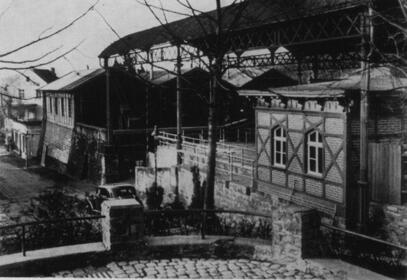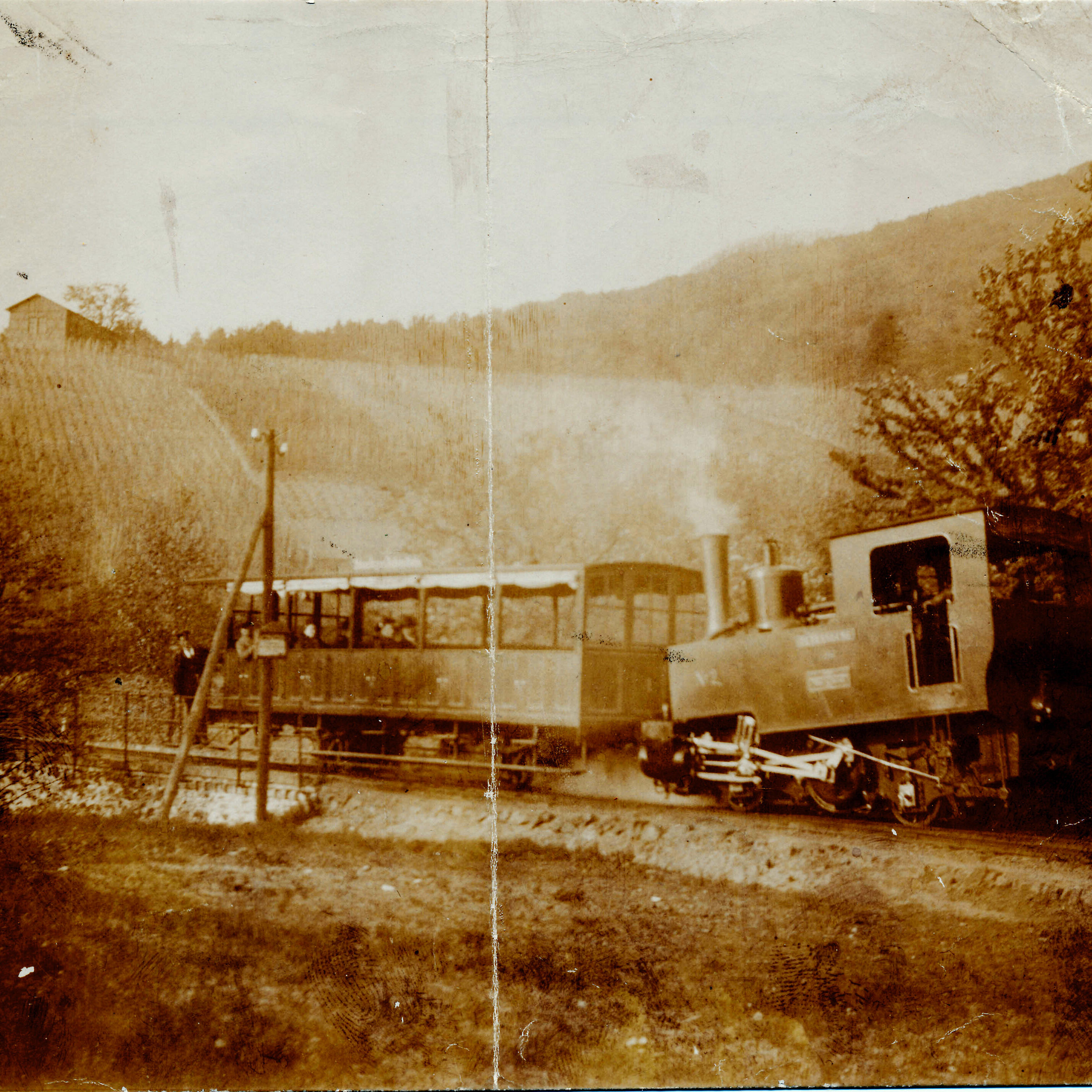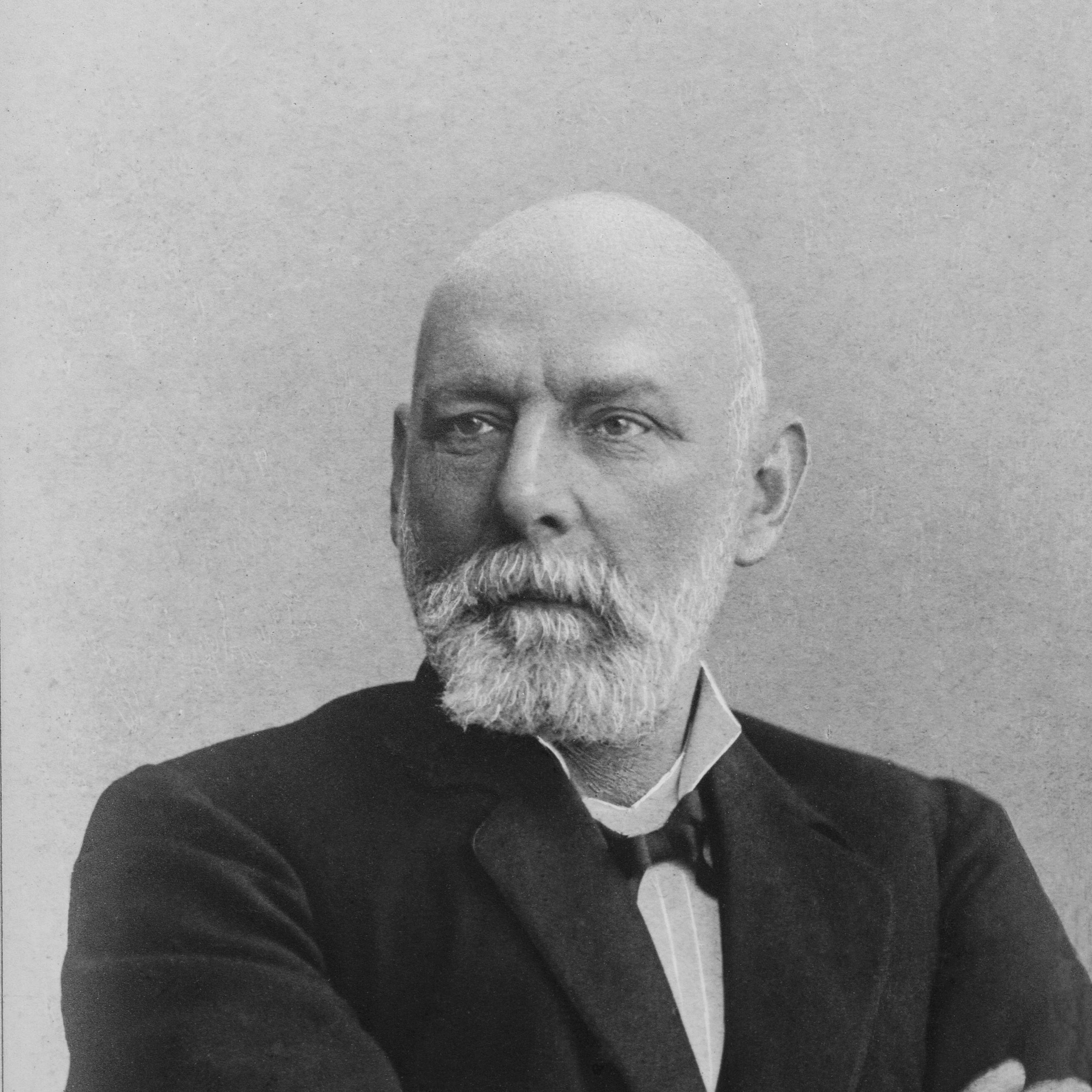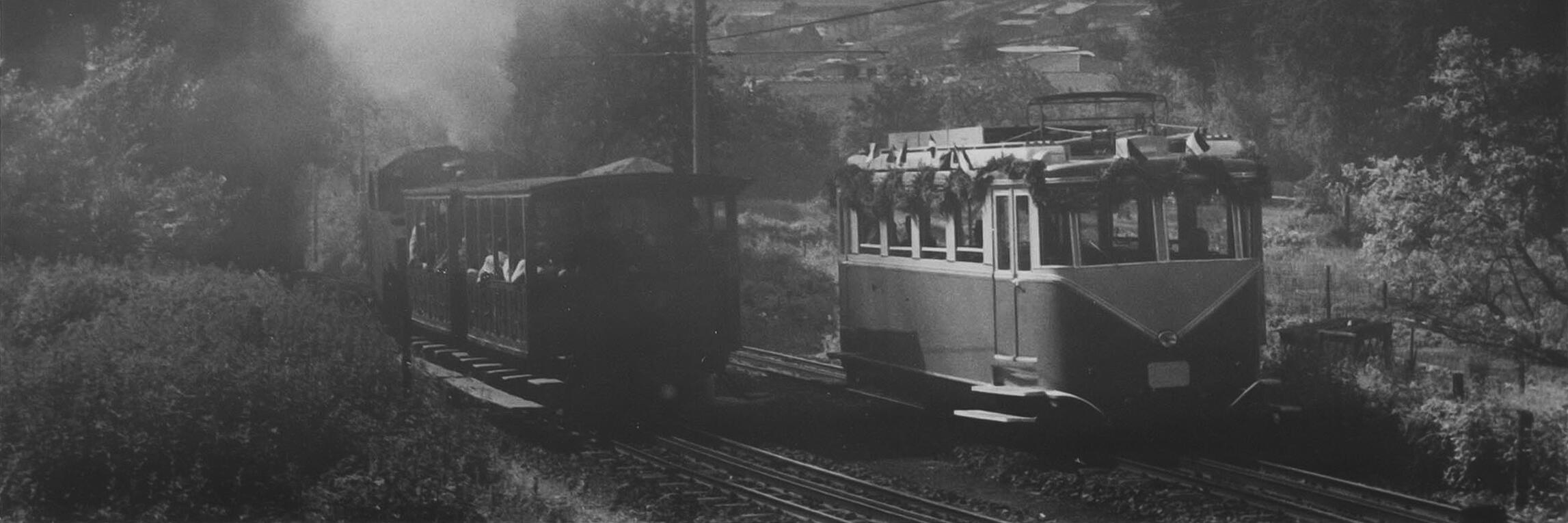
History
The long history of the oldest rack railroad in Germany - the Drachenfelsbahn
On August 12, 1881, the Deutsche Lokal- und Straßenbahngesellschaft (German Local and Tramway Company) applied for a concession to build a mountain railroad on the Drachenfels at the district president in Cologne.
On August 29, 1881, after only 17 days, the company received permission to build a "rack-and-pinion railroad from Königswinter to the Drachenfels plateau.
In November 1882, construction work begins according to the plans of engineer Riggenbach. A total of 23,000 m³ of earth had to be moved and 4,537 m³ of mortar masonry and 1211 m³ of dry masonry had to be built. Costs of around 617,000 Marks are incurred until the Drachenfelsbahn is put into operation on July 17, 1883.
On Friday, July 13, 1883
the maiden voyage takes place with prominent ladies and wives of prominent personalities.
On July 14, 1883, senior technical railroad and construction officials, the municipal council, and all operating and work personnel are driven to Drachenfels.
On July 17, 1883, scheduled operation of the Drachenfelsbahn begins, from the valley station in Königswinter to the plateau of the Drachenfels.
November 1883: The Drachenfelsbahn carries a total of 62,480 passengers in these few months (on 127 operating days).
In May 1888, construction of the Petersbergbahn begins.
On April 20, 1889, operation of the Petersbergbahn begins.
March 1913: Ferdinand Mülhens, the owner of "4711 - Echt kölnisch Wasser", buys the mountain railway company from the Deutsche Lokal- und Straßenbahngesellschaft. This also includes the cogwheel railroad, which was built in 1888 on the Petersberg. However, the operational management remains with the Deutsche Lokal- und Straßenbahngesellschaft.
In May 1914, Ferdinand Mülhens receives permission to extend the Petersbergbahn and improve the connection of the bottom station to the state railroad station in Königswinter.
In August 1914, World War I begins. Since most of the railroad staff is involved in the fighting, railroad operations come to a standstill. In the course of the war, operations are resumed in order to offer some diversion to vacationers, the wounded and the hard-pressed homeland.
On January 28, 1919, Ferdinand Mülhens registers a company to operate the Drachenfelsbahn in the Königswinter Commercial Register.
On May 3, 1919, the District President of Cologne approves the takeover of the operation of the tramway, from Königswinter to the Drachenfels (Drachenfelsbahn).
On May 21, 1920, the operation of the Petersbergbahn is resumed and the extension of the line to the Staatsbahnhof is opened.
In July 1923, Ferdinand Mülhens, with the approval of the Reichsbahndirektion, unites the Petersberg and Drachenfels rack railroads under the name "Bergbahnen im Siebengebirge AG".
On October 17, 1922, Ferdinand Mülhens is elected honorary citizen by the city council of Königswinter. As a reason for the award of the title, Mayor Clever emphasized that Ferdinand Mülhens had rendered great service to the city for many years as a member of the town council. Furthermore, he had rendered outstanding services to the general welfare by providing the rooms for the household school free of charge, and the same could be said of the gymnasium built by Mr. Mülhens, along with the adjacent public welfare building. No less highly the merits are to be attached, which he acquired during the war by his laborious assistance in all areas. Indirectly, Mr. Mülhens had safeguarded the interests of the city to a high degree by undertaking extensive road construction in the mountains and furthermore by substantially promoting tourism in the Siebengebirge through the buildings on the Petersberg (Kurhotel Petersberg).
On May 14, 1927, the private road to the Petersberg was ceremoniously opened.
On January 15, 1928, Ferdinand Mülhens passes away. He leaves his entire estates, which in Königswinter include the Petersberg with its hotel, the Wintermühlenhof estate and the Bergbahnen im Siebengebirge AG, to his son Peter Paul Mülhens (born 1875). He appoints Jakob Wetzels as commercial manager of all his Königswinter operations. At Bergbahnen im Siebengebirge AG, Wetzels is appointed sole director.
In 1933, attempts are made to put the management under political pressure with the threat of closing the business. However, Wetzels succeeds in preventing damage caused by measures taken by those in power through clever negotiations.
In September 1, 1939, with the invasion of Poland ordered by Adolf Hitler, the 2nd World War begins. Despite significant restrictions during the first years of the war, the operation of the Drachenfelsbahn is maintained. However, the operation of the Petersbergbahn is temporarily suspended. The annual report for the business year 1941 states: "The further withdrawal of manpower already mentioned in the previous year's annual report necessitated a fundamental change in the operational deployment and a far-reaching adaptation to wartime conditions. With the ten workers still remaining in the company, it was no longer possible to operate both rack railroads. Since further demands on the part of the workforce were to be expected, the management decided to expand the workshop operations by taking over production orders from other companies. The Drachenfelsbahn operated only on Sundays and holidays and the Petersbergbahn only on 4 days during the 1941 fiscal year."
During 1942 and 1943, the Drachenfelsbahn continues to operate only on Sundays and holidays. On workdays, the execution of production orders continues in the workshops. Due to a greatly reduced workforce, only the most urgent overhaul and repair work can be carried out during these years. The work usual in the pre-war period for the maintenance of the lines, the rolling stock, etc. has to be omitted.
At the beginning of September 1944, the Sunday service of the Drachenfelsbahn, which had been planned for the entire year, had to be discontinued, since the approach of the front brought immediate war effects to the area and made it impossible to maintain the service.
On March 24, 1945, Hans Mülhens was killed at the front. He is the youngest son of Peter Paul Mülhens and the family's hopeful, since his older brother Ferdinand Mülhens (II) had already died of diphtheria in 1938. Hans Mülhens was a member of the Supervisory Board for several years. The election of a 3rd Supervisory Board member necessitated by his death was not carried out. Instead, the post remained vacant until the end of the fiscal year 1945.
On May 8, 1945, World War II ended with the unconditional surrender of the Wehrmacht.
On August 5, 1945
Peter Paul Mülhens dies one day before his 70th birthday. The shares of Bergbahnen im Siebengebirge AG are divided equally among the heirs, his two daughters Maria Mülhens and Luise Streve (née Mülhens) and his minor grandson Ferdinand Mülhens (III) (1/3 each).
From March 1945, the operation of the railroads is suspended. Due to increased hostilities during the last months of the war, the infrastructure is severely damaged. In mid-March, American troops enter Königswinter and the Siebengebirge. As a result of the measures immediately imposed by the occupying forces, such as restrictions on going out, confiscation of housing, requisitions, etc., it is impossible to think of resuming work in the following weeks after the invasion. The buildings and track of the Drachenfelsbahn were considerably destroyed by previous shelling on Königswinter. Above the bottom station, the railroad line to Drachenfels takes a direct hit, likewise at the top station, causing severe damage to the viaduct. In addition, the troops passing through take a large number of tools and equipment by way of "informal requisition". Of the "rolling stock", only three cars were severely damaged, while the locomotives suffered relatively little damage. At the behest of the American occupation authorities, a large part of the remaining workforce is deployed for the construction of the Petersberg water supply system and for other cleanup and repair work on the Petersberg facilities.
On April 14, 1947, the Drachenfelsbahn is approved for operation again. Due to a lack of coal supplies, operation of the Drachenfelsbahn is limited to Sundays and holidays.
On June 21, 1948
the "money reorganization" takes place. The resulting general shortage of money brings about a complete change in the traffic situation. The transports of the Drachenfelsbahn in the month of July 1948 (Sunday transports) decrease to DM 3,373.55 (in the previous month until 20.6. RM 20,818.6). At the beginning of August, the traffic situation normalizes to such an extent that traffic can be resumed on weekdays as well. Both the number of passengers carried and the total revenue in the last 3 months of the 1948 driving season substantially exceed those in the same months of the last pre-war years. On November 1, 1948, the regular operation is stopped for the maintenance of the machines and the track.
On August 16, 1949, the Belgian occupation forces leave Petersberg. Immediately, the Allied High Commission, which was formed for the Federal Republic and Berlin after the Control Council ceased its activities in Berlin under the Three-Power Agreement of April 8, 1949, confiscates the hotel and all its facilities. Until 1953, the hotel on Petersberg is used by the High Commissioners as their administrative and advisory headquarters. The Petersberg Railway resumes business travel and goods traffic.
In the years 1951 and 1952
the valley station of the Drachenfelsbahn is renovated and rebuilt down to the foundation walls. The company responds to the rapidly increasing number of passengers on the Drachenfels and thus paves the way for future electrification of the line.
In April 1952, the Mannheim-based company Brown, Boveri & Cie. (BBC) is awarded the contract to electrify the Drachenfelsbahn in order to meet the demands of politicians and conservationists. The Siebengebirge is placed under "nature protection" as early as 1923, making it one of the oldest nature reserves in Germany.
On May 11, 1952, the confiscation of the Petersberg is lifted by the High Commission with an order. In July, the Allied High Commission ceases its work after almost 3 years of activity on Petersberg. From August 1952, the Rhine Terraces are reopened and Petersberg is open to the public.
In July 1953, with the commissioning of the ET 1, the electrification of the Drachenfelsbahn begins. Initially, however, the new, self-built car is used mainly during "off-peak" periods, as passenger capacity is limited to 60 people. The ET 1 is used for service on the Drachenfels until 1963.
In March 1955, the ET2 railcar enters service. This is built by Waggonfabrik Rastatt and equipped electrically by BBC. The new development has room for 80 passengers. The railcar is designed for multiple traction. After 72 years, electric railcars begin to replace steam engines. However, the steam locomotives continue to perform their service on the mountain until 1960.
1957: Commissioning of the ET3 railcar. Waggonfabrik Rastatt and BBC
In July 1958, the Drachenfelsbahn celebrates its 75th anniversary. It is a "record year" in many respects and the company presents itself as self-confident and full of confidence for the future.
On September 14, 1958
the unimaginable happens. At 6:45 p.m., locomotive 2 derailed below the mountain station of the Drachenfelsbahn during the last descent. The overturning locomotive sweeps away one of the three fully loaded observation cars. The second car runs into the crashed first car, and the third car can be brought to a halt. 17 people die and 112 others are injured, some seriously. The train service is immediately suspended until further notice. The tragic accident irrevocably puts "safety" first. While operation of the Petersbergbahn continues for the time being, it is discontinued at the end of 1958.
On March 14, 1959, the operation of the Drachenfelsbahn is resumed after a thorough survey and inspection of the line and the cars, but with the railcars ET2 and ET3 purely electric. The locomotive No.2II, built in 1927; is parked cold. In 1968, it is erected as a monument at the valley station of the Drachenfelsbahn Königswinter, where it still reminds visitors of the steam railway operation at Drachenfels.
In the same year, railcar ET4, Waggonfabrik Rastatt and BBC, enters service.
In 1960, railcar ET5, Waggonfabrik Rastatt and BBC, enters service for the Drachenfelsbahn.
On June 24, 1969, Luise Streve (née Mülhens), shareholder of Bergbahnen im Siebengebirge AG, is awarded honorary citizenship of the city of Königswinter. To this day, she is the only woman in the city of Königswinter to have received this honor.
In 1975, the operation of the Petersbergbahn is officially discontinued.
In March 1976, the middle station is moved from the Nibelungenhalle about 200 meters uphill, at the height of Schloss Drachenburg. The mountain restaurant is replaced by a new building and the second track at the top station is removed.
In 1978, a 5th railcar (ET6) is assembled using existing parts. The ET2-6 railcars are still in service today, while ET1 (self-built) was already taken out of service in 1963 and found a use as a "construction hut" at the Thomas company in Bonn-Beuel.
On April 1, 1979, Jürgen Limper joins the Drachenfelsbahn company as a board member. He will manage the company with great skill for over 34 years.
In September 1979, the Mülhens community of heirs, consisting of Maria Mehl- Mülhens, Luise Streve and Ferdinand Mülhens (III), sells the Petersberg to the Federal Republic of Germany. The hotel has already been closed since 1969 and is only opened briefly for the state visit of the General Secretary of the USSR, Leonid Brezhnev, in 1973. The site of the former valley station of the Petersberg cable car remains in family ownership.
On April 21, 1985, the shareholder Maria Mehl- Mülhens dies. She is childless and leaves her shares to her nephew Dieter J. H. Streve- Mülhens, son of her sister Luise Streve, honorary citizen of the city of Königswinter.
Luise Streve, the only honorary citizen of the city of Königswinter, dies on June 11, 1990. She leaves her shares to her grandson Dieter G. A. Streve- Mülhens.
In 1998, a comprehensive overhaul of all electric railcars in service on the Drachenfelsbahn is begun by the Swiss Locomotive and Machine Works (SLM) Winterthur. In the process, the vehicles as a whole are brought up to the latest state of the art in mountain railway technology. Completion of all the cars takes place between 1999 and May 2000.
In 1999, the Drachenfelsbahn, which includes the cars, the valley, middle and top stations, as well as the entire route up the Drachenfels, is placed under a preservation order.
In January 2004: the planning work for the reconstruction of the valley station of the Drachenfelsbahn begins. Tourism at the Drachenfels in the Siebengebirge and in Königswinter has reached historic lows for visitors due to a lack of renewal and a strong decline in the quality of the offer. In order to give the region an incentive for renewal, a concept is being developed in just three months that combines the three parts, railroad station, tourist information and exhibition site under one roof. The "Drachenfels Tourist Station" is born on paper.
In July 2004, Fiona Streve- Mülhens Achenbach buys the shares from Ferdinand Mülhens (III).
In October 2004, renovation and conversion work begins. A total budget of 1.97 million euros is available for the redesign of the bottom station. This sum is borne in equal parts by Bergbahnen im Siebengebirge AG and the federal government (as part of the "Bonn-Berlin compensation").
On March 31, 2005, work on the bottom station is completed and the "Drachenfels Tourist Station" is officially opened under the patronage of Wolfgang Clement, Federal Minister of Economics and Labor.
In 2008, the Drachenfelsbahn celebrates its 125th anniversary.
Between 2010 and 2011 the middle station gets a new face.
2012 - 2013 the redesign of the top station takes place in the course of the renovation of the mountain restaurant.
On December 31, 2012, Jürgen Limper will leave the company after 34 years of service. Klaus Hacker is appointed to the board as his successor.
In 2018, the Drachenfelsbahn celebrates its 135th anniversary. On the occasion of this anniversary, the photo artist Christian Klant, born in Königswinter, is commissioned to take photographs with the "collodion wet plate process" he uses, from the beginnings of photography more than 150 years ago. The result of his creative work will be exhibited in an exhibition entitled "Man, Mountain, Technology" in the valley station and later in the Siebengebirgsmuseum of the city of Königswinter.
On September 14, 2018, on the occasion of the 60th anniversary of the railroad accident of 1958, with 17 dead and 112 injured, a memorial service will be held at the valley station of the Drachenfelsbahn. At this commemoration, in memory of the accident and the victims, a hand-forged iron statue and a commemorative plaque will be unveiled on the outside wall of the valley station, below the alarm bell that was rung at the time. The statue represents the Roman god Mercury. He is considered the god of traffic, travelers and science, and embodies the spiritual mobility that led to extensive reflection and changes in safety standards after the 1958 accident. The statue is about 2 meters high and was created by artist Burkhard Mohr from Königswinter.
May 16, 2019, after 135 years, 300 days and 20 minutes, the speedometer of Germany's oldest rack railroad, stands at more than three million total kilometers run.
On March 16, 2020, the Drachenfelsbahn, for the protection of guests and employees, stopped its operation due to the onset of the Corona pandemic. In the following months, despite high safety measures, the ride operation has to be stopped several times. The entire staff remains loyal to the company and when the end of the pandemic seems to have come in the winter of 2021, the company expands its workforce.
On Dec. 31, 2021, Klaus Hacker, the company's CEO, retires. During the last two fiscal years, which were marked by the pandemic, he succeeded in securing the company's continued existence and maintaining the workforce.
On January 1, 2022, Thomas Scharf will succeed him as CEO. On the same day, the Drachenfelsbahn resumes regular operations on the mountain after a pandemic of almost 2 years.
On July 14, 2022, Bergbahnen im Siebengebirge Aktiengesellschaft announces that it has changed its legal form and will now continue as a limited liability company ("GmbH"). The change of legal form is primarily a formal act and serves to simplify and modernize the structures of the historically grown company. As a modern legal form, the GmbH also enables the owner family to participate more closely than before in day-to-day operations. Fiona Streve- Mülhens Achenbach, shareholder and most recently Chairwoman of the Supervisory Board, becomes a further Managing Director of the company alongside Thomas Scharf, who now acts as Managing Director.


